Condensation polymers Study guides, Revision notes & Summaries
Looking for the best study guides, study notes and summaries about Condensation polymers? On this page you'll find 371 study documents about Condensation polymers.
Page 3 out of 371 results
Sort by
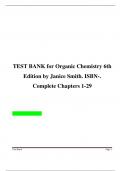
-
TEST BANK for Organic Chemistry 6th Edition by Janice Smith. ISBN-. Complete Chapters 1-29 Updated A+
- Exam (elaborations) • 620 pages • 2023
-
- £10.53
- + learn more
TEST BANK for Organic Chemistry 6th Edition by Janice Smith. ISBN-. Complete Chapters 1-29 Updated A+TABLE OF CONTENTS Chapter 1 Structure and Bonding Chap ter 2 Acids and Bases Chapter 3 Introduction to Organic Molecules and Functional Groups Chapter 4 Alkanes Chapter 5 Stereochemistry Chapter 6 Understanding Organic Reactions Chapter 7 Alkyl Halides and Nucleophilic Substitution Chapter 8 Alkyl Halides and Elimination Reactions Chapter 9 Alcohols, Ethers, and Related Compounds Chapter 10 Alken...
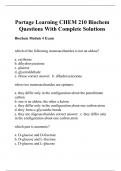
-
Portage Learning CHEM 210 Biochem Questions With Complete Solutions
- Exam (elaborations) • 13 pages • 2023
- Available in package deal
-
- £10.53
- + learn more
which of the following monosaccharides is not an aldose? a. erythrose b. dihydroxyacetone c. glucose d. glyceraldehyde e. ribose correct answer: b. dihydroxyacetone when two monosaccharides are epimers: a. they differ only in the configuration about the penultimate carbon b. one is an aldose, the other a ketose c. they differ only in the configuration about one carbon atom d. they form o-glycosidic bonds e. they are oligosaccharides correct answer: c. they differ only in the ...
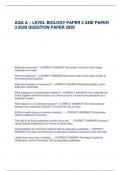
-
AQA A – LEVEL BIOLOGY PAPER 2 AND PAPER 3 2020 QUESTION PAPER 2020
- Exam (elaborations) • 29 pages • 2023
- Available in package deal
-
- £10.13
- + learn more
AQA A – LEVEL BIOLOGY PAPER 2 AND PAPER 3 2020 QUESTION PAPER 2020 What are monomers? - CORRECT ANSWER-The smaller units from which larger molecules are made What are polymers? - CORRECT ANSWER-Molecules made from a large number of monomers joined together What are examples of monomers? - CORRECT ANSWER-Monosaccharides, amino acids and nucleotides What happens in a condensation reaction? - CORRECT ANSWER-Two molecules are joined together with the formation of a chemical bond, it invol...

-
Chem 210 Portage Learning Exam #4 | Questions and Verified Answers| 2023/ 2024 Update
- Exam (elaborations) • 14 pages • 2023
- Available in package deal
-
- £7.70
- + learn more
Chem 210 Portage Learning Exam #4 | Questions and Verified Answers| 2023/ 2024 Update Question Which of the following monosaccharides is not an aldose? Erythrose Dihydroxyacetone Glucose Glyceraldehyde Ribose Question When two monosaccharides are epimers: They differ only in the configuration about the penultimate carbon One is an aldose, the other a ketose They differ only in the configuration about one carbon atom They form O-glycosidic bonds They are oligosacch...
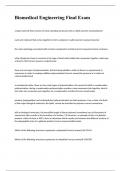
-
Biomedical Engineering Final Exam with correct answers
- Exam (elaborations) • 12 pages • 2023
-
- £12.97
- + learn more
a large molecule that consists of many repeating structural units is called acorrect answerpolymer each unit molecule that comes together to form a polymer is called acorrect answermonomer the main advantage associated with ceramics compared to metals iscorrect answercorrosion resistance what all polymers have in common is the type of bond which holds their monomers together. what type of bond is this?correct answera covalent bond there are two types of polymerization, the first bein...
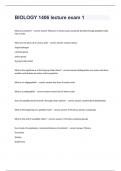
-
BIOLOGY 1406 lecture exam 1 Collin College - Question and answers rated A+
- Exam (elaborations) • 20 pages • 2024
- Available in package deal
-
- £12.16
- + learn more
BIOLOGY 1406 lecture exam 1 Collin College - Question and answers rated A+ BIOLOGY 1406 lecture exam 1 What are proteins? - correct answer Polymers of amino acids covalently bonded through peptide bonds into a chain What are the parts of an amino acid? - correct answer central carbon single hydrogen carboxyl group amino group R-group {side chain} What is the significance of the R-group {side chain}? - correct answer distinguishes one amino acid from another and dictates an am...
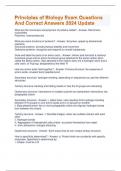
-
Principles of Biology Exam Questions And Correct Answers 2024 Update
- Exam (elaborations) • 18 pages • 2024
- Available in package deal
-
- £9.72
- + learn more
Principles of Biology Exam Questions And Correct Answers 2024 Update What are the monomers and polymers of proteins called? - Answer -Monomers- nucleotides Polymers- macromolecules What are some functions of proteins? - Answer -Enzymes- speed up biochemical reactions Structural proteins- provide physical stability and movement Defensive proteins- recognize and respond to nonself substances Draw and label the parts of an amino acid. - Answer -Amino acid has both a carboxyl functiona...
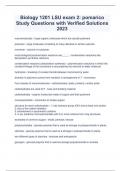
-
Biology 1201 LSU exam 2: pomarico Study Questions with Verified Solutions 2023
- Exam (elaborations) • 8 pages • 2023
-
- £8.91
- + learn more
macromolecules - large organic molecules which are usually polymers polymers - large molecules consisting of many identical or similar subunits monomer - subunit of a polymer most biological polymerization reactions are_____ - condensation reactions aka dehydration synthesis reactions condensation reactions (dehydration synthesis) - polymerization reactions in which the covalent linkage of the monomers is accompanies by removal of water molecule hydrolysis - breaking of covalent b...
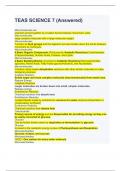
-
TEAS SCIENCE 7 (Answered)
- Exam (elaborations) • 9 pages • 2024
-
- £8.51
- + learn more
TEAS SCIENCE 7 (Answered) Macromolecules are polymers joined together by covalent bonds between monomeric units. Macromolecules large complex molecules with a large molecular weight. Macromolecules Function as food groups and the digestion process breaks down the bonds between monomers by hydrolysis. Macromolecules 4 Basic Organic Compounds: [Produced by Anabolic Reactions] Carbohydrates (Polysaccharides), Nucleic Acids, Proteins, and Lipids. Macromolecules 4 Basic Building Blocks:...
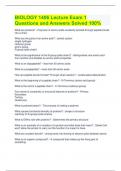
-
BIOLOGY 1406 Lecture Exam 1 Questions and Answers Solved 100%
- Exam (elaborations) • 13 pages • 2024
- Available in package deal
-
- £9.72
- + learn more
What are proteins? - Polymers of amino acids covalently bonded through peptide bonds into a chain What are the parts of an amino acid? - central carbon single hydrogen carboxyl group amino group R-group {side chain} What is the significance of the R-group {side chain}? - distinguishes one amino acid from another and dictates an amino acid's properties What is an oligopeptide? - less than 50 amino acids What is a polypeptide? - more than 50 amino acids How are peptide bonds...

Did you know that on average a seller on Stuvia earns £76 per month selling revision notes? Hmm, hint, hint. Discover all about earning on Stuvia


